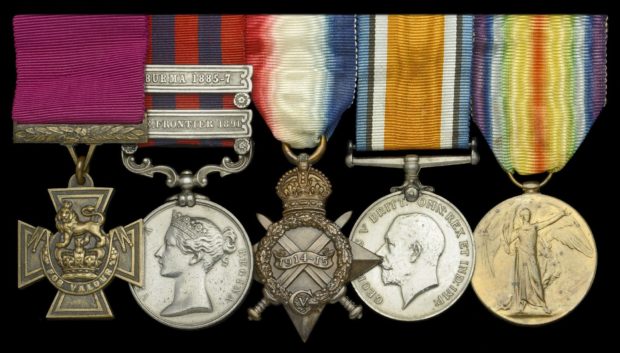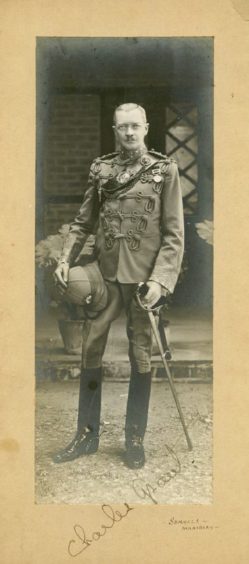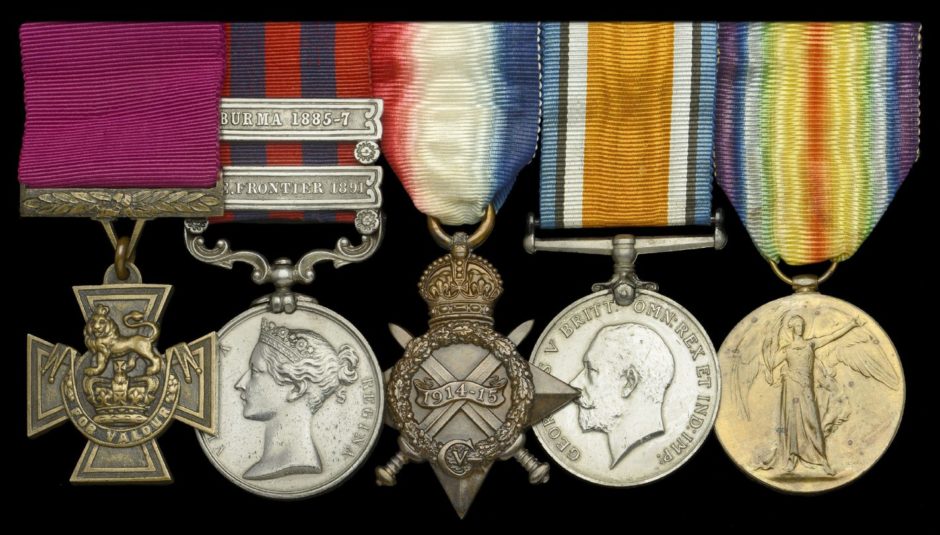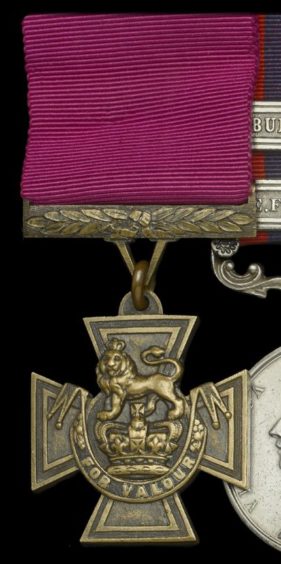A Victoria Cross awarded to an Oldmeldrum colonel who fought off 2,000 men with only 80 troops in a battle during the British Raj has sold for £420,000.
The medal was part of a collection belonging to Colonel Charles James William Grant which was sold for a record price this week at auction.
He was a lieutenant with the 12th Regiment (2nd Burma Battalion) Madras Infantry when he fought in the Anglo-Manipur War in 1891.
The conflict took place between the British Empire and the Manipur Kingdom during a now controversial time in Britain’s colonial history.
The 29-year-old soldier was born at Bourtie near Oldmeldrum in Aberdeenshire and attended the Royal Military College at Sandhurst after a private education.
The son of a Lieutenant-General, he was commissioned as a Lieutenant in the Suffolk Regiment on May 10 1882, and joined the Madras Staff Corps in 1884.
He led his men during the Battle of Thoubal where just 80 soldiers fought off wave after wave of attack, facing down an estimated 2,000 enemy forces.
The month-long conflict on the North East Frontier of India saw Grant earn the nickname the “Hero of Manipur” for his bravery.
There had been deep unrest in Manipur for decades in the 1800s after its occupation by Burma, and then the death of the popular Crown Prince Maharaja Narasingh in 1850.
The state remained strategically important to Britain, which had annexed Upper Burma in 1886.
Britain deployed an army to Manipur in September 1890, after the ruling Maharaja Surchandra fled to Calcutta following a palace coup led by his younger brother, the rebel Prince Tikendrajit.
The rebel insurgents declared Kulachandra, the next oldest brother, as king.
War broke out on March 31 1891 when the new king rejected the aggressive imposition of British rule in Manipur.
On March 27, amid the rising tensions, Col Grant had led an expedition in Manipur of 50 of his own infantry soldiers and around 35 members of the 43rd Gurkha Regiment.
The British had made it to the village of Thoubal, but on April 1, 2,000 armed Manipur troops laid seige on Col Grant and his men.
Col Grant and his small battalion faced days of attacks and hand-to-hand combat, but successfully defended Thoubal, and he was hailed a hero.
The British only lost only one soldier compared to heavy casualties suffered by the Manipuri forces.
The British column of troops retreated from Thoubal to join others, before facing further clashes with Manipuri soldiers.
War ended on April 27 when the Union Jack was hoisted above the Kangla Palace.
The Anglo-Manipuri war faced international criticism at the time, with even Queen Victoria raising concerns about the treatment of Prince Tikendrajit who was hanged in August 1891.
After the conflict, Col Grant was awarded the Victoria Cross – the highest British military decoration awarded for valour.
He was gazetted and received the honour for “the conspicuous bravery and devotion to his country displayed by him on having, on hearing on March 27 1891, of the disaster at Manipur, at once volunteered to attempt the relief of the British captives with 80 native soldiers, and having advanced with the greatest intrepidy, captured Thoubal, near Manipur, and held it against a large force of the military”.
Col grant went on to have a long military career and was attached to the 3rd Royal Scots before retiring from the Army in 1913.
He moved to Sidmouth in Devon, where he died in 1932, aged 71 years.
His death made headlines around the world, such was the legend of his bravery in the Anglo-Manipuri war.
His medals were sold by London auction house Dix Noonan Webb on behalf of a collector to an unnamed bidder for £420,000.
The record sale exceeded the estimate of £400,000.
Col Grant’s unpublished leather bound ‘Officer’s Field Note and Sketch Book and Reconnaissance Aide-Memoire’ in which he meticulously records the march to Manipur and the capture and subsequent defence of Thoubal were also sold with the VC.
A file of original letters, including the negotiations between Grant and the Manipuris and a coded message from Grant in Greek characters to the relief force were also part of the collection.
Medal expert Mark Quayle, from Dix Noonan Webb, said it was “an outstanding VC group and important archive”.













